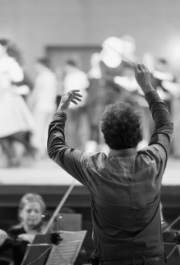Gabriel Fauré
12 May 1845 – 4 November 1924) was a French composer, organist, pianist and teacher. He was one of the foremost French composers of his generation, and his musical style influenced many 20th-century composers.
Pelléas et Mélisande Suite, Op. 80
1898년, 동명의 희곡의 부수음악으로 작곡된 것이다.
오늘날 이 작품은 극 부수음악에서 4악장을 발췌하여 4곡의 모음곡 형태로 연주되고 있다.
Performed by Boston Sinfonia, Seigi Ozawa conductor
00:00 - No. 1 Prélude - Quasi adagio
06:24 - No. 2 Fileuse (Hilandera) - Andantino quasi allegretto
08:58 - No. 3 Sicilienne - Allegretto molto moderato
13:02 - No. 4 La Mort de Mélisande - Molto adagio
많은 작곡가들에게 영감을 준 희곡
〈펠레아스와 멜리장드〉는 벨기에의 극작가 모리스 메테를링크(Maurice Maeterlinck, 1862~1949)의 희곡이다. 포레는 이 연극의 런던 프로덕션을 위해 곡을 썼고, 그것이 오늘날의 〈펠레아스와 멜리장드〉의 토대가 되었다. 메테를링크의 극은 20세기 전환기 많은 음악인들에게 큰 영향을 미쳤다. 드뷔시는 같은 타이틀로 오페라를 남겼고, 쇤베르크 역시 같은 제목의 교향시를, 얀 시벨리우스는 극 부수음악으로 만든 모음곡을 남겼다. 이들 작품들 중에서 오늘날 가장 대중적으로 널리 알려진 것은 바로 포레의 작품이다.
어두운 사랑 이야기
〈펠레아스와 멜리장드〉는 어두운 사랑 이야기에 그 바탕을 두고 있다. 골로 왕자는 사냥 여행 도중에 신비로운 소녀, 멜리장드를 숲 속에서 홀로 맞닥뜨린다. 깨질 것만 같은 그녀의 아름다움에, 왕자는 그녀에게 자신이 가지고 있는 오래된 성에 쉴 곳을 마련해주고, 그녀에게 청혼을 한다. 그녀는 왕자의 호의를 받아들이지만, 그녀는 왕자의 이복 형제 펠레아스에게 마음이 있다. 그러나 멜리장드를 향한 왕자의 마음은 점차 질투의 마음으로 변하여 그는 둘을 죽이게 된다. 〈펠레아스와 멜리장드〉는 물에 가라앉은 왕관과 반지, 돌아가는 물레 등을 통해 극에 상징성을 부여하고 있다.
시공간을 초월한 듯한 아름다움
포레가 이 극에 곡을 쓴 것은 1898년이었다. 1901년부터 1909년 사이 그는 이 부수음악에서 4개의 곡을 골라서 연주회용 모음곡으로 만든다. 포레의 〈펠레아스와 멜리장드〉는 이 극이 가진 전설적인 성격과 시간을 초월한 듯한 성격을 부각시키는 1곡 전주곡으로 시작한다. 꿈을 꾸는 듯한 몽환적인 분위기가 전체를 지배하다가 극이 시작하면서 골로 왕자가 등장함을 알리는 호른 콜과 함께 꿈을 꾸는 분위기는 깨어진다. 2악장은 멜리장드가 그녀의 물레를 돌리고 있는 장면을 그린다. 물레가 소리를 내며 돌아가는 소리는 현악기의 빠른 음형을 통해서 묘사되고, 여기에 목관악기는 선율적인 아이디어를 제시하면서 대비감을 부여한다. 3악장은 유명한 시실리엔 악장이다. 여기에서 마치 오래 전 이야기를 떠올리는 듯한 고풍스러운 멜로디는 하프가 만들어내는 잔잔한 아르페지오의 반주를 타고 아름답게 흐른다. 사실 이 곡은 처음부터 〈펠레아스와 멜리장드〉를 위해서 만들어진 것은 아니었다. ‘시실리엔’은 또 다른 극 부수음악 〈부르주아 귀족〉의 한 곡으로 쓰기 위해서 이전에 작곡된 곡이었다. 이 모음곡은 4악장 멜리장드의 죽음, 죽은 여주인공을 향한 아름다운 엘레지(Élégie)로 마감한다.
글-정이은 / 출처 클래식 백과
클래식 백과
Pelléas et Mélisande, Op. 80 is a suite derived from incidental music by Gabriel Fauré for Maurice Maeterlinck's play of the same name. He was the first of four leading composers to write music inspired by Maeterlinck's drama. Debussy, Schoenberg and Sibelius followed in the first decade of the 20th century. Fauré's music was written for the London production of Maeterlinck's play in 1898. To meet the tight deadline of the production, Fauré reused some earlier music from incomplete works and enlisted the help of his pupil Charles Koechlin, who orchestrated the music. Fauré later constructed a four-movement suite from the original theatre music, orchestrating the concert version himself.
The suite at first consisted of the Prélude, Fileuse (entr'acte to Act 3) and La mort de Mélisande (entr'acte to Act 4). In this form it was premiered at the Concerts Lamoureux in February 1901. Fauré was not happy with the performance, telling his wife that the conductor, Camille Chevillard did not really understand the music. Fauré later added the Sicilienne. This version of the suite was published in 1909. The suite is sometimes performed with the addition of Mélisande's song "The King's three blind daughters", in Koechlin's orchestration.
The Prélude is based on two themes; the first is tightly restricted, with no large melodic intervals between successive notes. The critic Gerald Larner suggests that this theme reflects Mélisande's introverted personality. The second theme is introduced by a romantic solo cello with woodwind, and may, in Larner's view represent Mélisande as first seen by her future husband, Golaud. The horn calls near the end of this movement may suggest Golaud's discovery of Mélisande in the forest.
La Fileuse is an orchestral representation of a spinning song. The Fauré scholar Jean-Michel Nectoux notes that although Debussy omits it in his operatic version, Mélisande is shown at her spinning wheel in Maeterlinck's play. A gentle oboe melody is accompanied by the strings, who maintain a theme imitative of spinning.
The last movement, in D minor, is inescapably tragic, with a theme of lamentation for clarinets and flutes. There are echoes of Mélisande's song throughout the movement. The opening theme returns fortissimo on the strings "before a last echo of the song and a sadly modal approach on solo flute to the final chord" (Larner). This movement was played at Fauré's own funeral.
I. Prélude (Vorspiel). Quasi Adagio ∙
II. Fileuse (Spinnerlied). Andantino quasi Allegretto ∙
III. Sicilienne (Sizilianisches Lied). Allegretto molto moderato ∙
IV. La mort de Mélisande (Melisandes Tod). Molto Adagio ∙
hr-Sinfonieorchester – Frankfurt Radio Symphony ∙
François Leleux, Dirigent ∙
hr-Sendesaal , 12. Mai 2017 ∙
'♣ 음악 감상실 ♣ > - 가브리엘 포레' 카테고리의 다른 글
| Gabriel Faure - Piano Trio in D minor, Op. 120 (0) | 2021.05.22 |
|---|---|
| Gabriel Fauré- Allegro from Symphony en Fa or Suite d’Orchestre Op 20 (0) | 2019.09.18 |
| Gabriel Fauré - Barcarolle 모음 (0) | 2018.11.27 |
| Gabriel Fauré - Cello Works (0) | 2018.08.27 |
| Gabriel Faure- Piano Quartet No. 1 in C minor, op. 15 (0) | 2017.05.01 |


